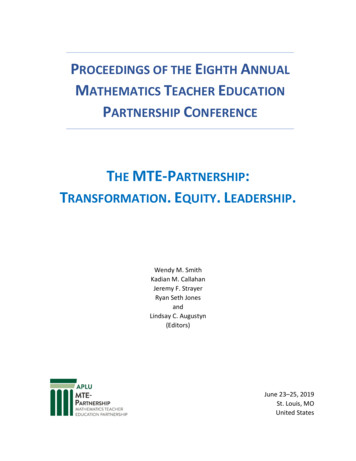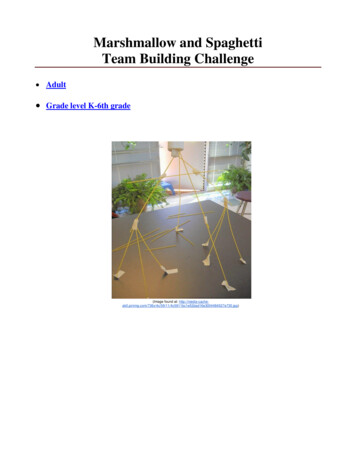
Transcription
PROCEEDINGS OF THE EIGHTH ANNUALMATHEMATICS TEACHER EDUCATIONPARTNERSHIP CONFERENCETHE MTE-PARTNERSHIP:TRANSFORMATION. EQUITY. LEADERSHIP.Wendy M. SmithKadian M. CallahanJeremy F. StrayerRyan Seth JonesandLindsay C. Augustyn(Editors)June 23–25, 2019St. Louis, MOUnited States
iiProceedings of the Eighth Annual Mathematics Teacher Education Partnership ConferenceEdited by Wendy M. Smith, Kadian M. Callahan, Jeremy F. Strayer, Ryan Seth Jones and Lindsay AugustynFirst published October, 2019Published by the Association of Public and Land-grant Universities (APLU)Proceedings available at cles published in the Proceedings are copyrighted by the author. Permission to reproduce an article orportions from an article must be obtained from the author.ISBN: 978-1-7923-2250-1Cite Proceedings Volume as:Smith, W. M., Callahan, K. M., Strayer, J. F., Jones, R. S., & Augustyn, L. C. (Eds.). (2019). Proceedings of the eighthannual Mathematics Teacher Education Partnership conference. Washington, DC: Association of Public andLand-grant Universities.Cite Proceedings Chapter as:Author. (2019). Title of chapter. In W. M. Smith, K. M. Callahan, J. F. Strayer, R. S. Jones, & L. C. Augustyn(Eds.), Proceedings of the eighth annual Mathematics Teacher Education Partnership conference (pp.XX–XX). Washington, DC: Association of Public and Land-grant Universities.Mathematics Teacher Education Partnership Co-DirectorsW. Gary Martin, Auburn UniversityHoward Gobstein, Association of Public and Land-grant Universities1,2Mathematics Teacher Education Partnership Planning CommitteeAlyson Lischka, Middle Tennessee State UniversityW. Gary Martin, Auburn University, co-chairJames Martinez, University of Tennessee, KnoxvilleHoward Gobstein, Association of Public and Landgrant Universities, co-chairJulie McNamara, California State University, East BayLisa Amick, University of KentuckyMargaret J. Mohr-Schroeder, University of KentuckyEd Dickey, University of South CarolinaJennifer Oloff-Lewis, California State University, ChicoMark Ellis, California State University, FullertonRobert N. Ronau, University of LouisvilleMaria Fernandez, Florida International UniversityWendy M. Smith, University of Nebraska-LincolnDana Franz, Mississippi State UniversityDenise Schulz, North Carolina Dept. of Public InstructionBrian R. Lawler, Kennesaw State UniversityMarilyn Strutchens, Auburn UniversityJim Lewis, University of Nebraska–LincolnDavid Webb, University of Colorado at BoulderAcknowledgmentsFunding for the MTE-Partnership, including the 2019 Conference, was provided in part by grants from the NationalScience Foundation (DUE-1834539 and DUE-1834551)2.Special thanks to Lindsay Augustyn of the University of Nebraska–Lincoln and Nathalie Dwyer of APLU for theirassistance in planning and executing the logistics for the 2019 MTE-Partnership Conference.PrefaceThese proceedings are a written record of the presentations and papers presented at the Eighth AnnualMathematics Teacher Education Partnership Conference held in St. Louis, June 23–25, 2019. The theme for theconference was “The MTE-Partnership: Transformation. Equity. Leadership.” We are pleased to present theseProceedings as a resource for the mathematics and mathematics education community.www.mte-partnership.org1 Robert N. Ronau participated as a member of the MTE-PartnershipPlanning Team while serving at the National Science Foundation.2 Any opinion, findings, and conclusions or recommendations expressed inthis material are those of the authors and do not necessarily reflect theviews of the National Science Foundation.
iiiCONTENTSINTRODUCTIONThe Eighth Annual MTE-Partnership Conference: The Beat Goes On . 2W. Gary Martin, Howard Gobstein, & Wendy M. SmithOverview of the Conference . 10Wendy M. SmithPANEL TALKS AND WORKING GROUPSTransformations Panel . 13Dana Pomykal Franz, Marilyn E. Strutchens, Margaret J. Mohr-Schroeder, Wendy M. Smith,& W. Gary MartinEquity & Social Justice Working Group . 20Ruthmae Sears, Travis Weiland, & Brian R. LawlerRESEARCH ACTION CLUSTER REPORTSClinical Experiences . 27Marilyn Strutchens, Ruthmae Sears, Jeremy Zelkowski, Belinda Edwards, Basil Conway IV,& Charmaine MangramActive Learning Mathematics (ALM). 34Wendy M. SmithThe Mathematics of Doing, Understanding, Learning, and Educating for Secondary Schools(MODULE(S2)) . 37Alyson E. Lischka & Lindsay CzapProgram Recruitment & Retention (PR2) . 39Julie McNamara, Dana Pomykal Franz, & Maria L. FernandezSecondary Teacher Retention & Induction in Diverse Educational Settings (STRIDES) . 41Lisa AmickRESEARCH PRESENTATIONSMathematical Modeling Lesson Adaptation for Increasing Local Relevance . 45Will Tidwell & Brynja R. Kohler
ivFinding their Voice: Support Mechanisms to Engage and Empower Future Mathematics Teachers . 56Kelly Gomez Johnson, Paula Jakopovic, Angie Hodge, Neal Grandgenett, Michael Matthews, &Janice RechSharing and Building Resources to Equip and Empower Mathematics Teacher Educators . 65Basil Conway IV & Jamalee (Jami) StoneDeveloping a Framework for Equitable Mathematics Instruction. 75Nancy KressInculcation of Pre-service Mathematics Teacher Social Consciousness Through Social JusticeMathematical Modeling Projects. 84Patrick L. Seegmiller & Brynja R. KohlerPaired Placement Internships: Clinical Teaching Becomes A Collaborative and Empowering Model forOngoing Professional Development . 96Charmaine Mangram, Basil Conway IV, Marilyn E. Strutchens, Ruby Ellis & David EricksonUsing Assessment Frameworks to Inform the Design of Classroom Assessment . 116David WebbPRESENTATION ABSTRACTSTransparency and the Big Ideas in Calculus: Using a Write/Feedback/Re-write Cycle to Improve StudentUnderstanding . 128Tabitha Mingus & Melinda KoellingUsing Co-Teaching to Develop Classroom Mathematical Discourse During Clinical Experiences . 129Ruthmae Sears & Cynthia Castro-MinnehanDevelopment of Equity Literacy in the MODULE(S2) Statistics for Secondary Teachers Course . 130Melody WilsonThe Power of Collaboration: A Taste of Improvement Science . 131Qualyn McIntyre & Pier A. Junor ClarkeComparing Secondary Teachers’ MKT for Geometry Exposed in Video and Written Representations ofPractice . 132Alyson E. Lischka, Yvonne Lai, & Jeremy F. StrayerLearning to Teach Statistics for Social Justice . 133Stephanie Casey, Andrew Ross, Samantha Maddox, & Melody WilsonPathways Through Calculus . 134James HartPreparing Secondary Mathematics Teachers in Statistics Through a Dynamic Repository . 135
vKimberleigh HadfieldProgram Recruitment and Retention (PR2) . 136Julie McNamara, Dana Pomykal Franz, Diane Barrett, Cheryl Ordorica, & Carol Fry BohlinImpacting Teacher Retention by Supporting Secondary Mathematics Teachers in their First Year ofTeaching . 137Lisa Amick, Judy Kysh, Lisa Lamb, James Martinez, April Pforts, Frederick Uy, Travis Weiland,Laura Wilding, & Cathy WilliamsFindings from the First Year of Implementation of the Modeling Practices in Calculus Curriculum. 138Charity WatsonAn Operational Framework of Active Learning . 139Sean YeeA Dialogue on the Liaising Structure of the Equity and Social Justice Working Group . 141Travis Weiland & Brian R. Lawler
INTRODUCTION
2The Eighth Annual MTE-Partnership Conference:The Beat Goes OnW. Gary Martin, Auburn University, martiwg@auburn.eduHoward Gobstein, Association of Public and Land-grant Universities, hgobstein@aplu.orgWendy M. Smith, University of Nebraska-Lincoln, wsmith5@unl.eduThe Mathematics Teacher Education Partnership (MTE-Partnership) was formed by the Association ofPublic and Land-grant Universities (APLU) in 2012 to address a major problem in secondary mathematics teacherpreparation: a shortage of secondary mathematics teachers entering the profession who are well prepared toensure their students can meet rigorous state mathematics standards for college- and career-readiness, with aninitial focus on the Common Core State Standards for Mathematics (CCSS-M) (National Governors AssociationCenter for Best Practices & Council of Chief State School Officers, 2010) and other documents. This consortium ofover 90 universities and over 100 school systems has a common goal of transforming secondary mathematicsteacher preparation using the networked improvement community (NIC) design (Bryk, Gomez, Brunow, &LeMahieu, 2015). This paper provides a brief overview of the development of the MTE-Partnership and how thegoals for the Eighth Annual MTE-Partnership Conference, held in June 2019, supported its continuing progress.An Overview of the MTE-PartnershipThe APLU’s 2011 Annual Conference of the Science and Mathematics Teaching Imperative (SMTI) focusedon how higher education might respond to the just-released CCSS-M, with a particular focus on changes necessaryin teacher preparation. A group of attendees at the conference submitted a white paper to the SMTI ExecutiveCommittee proposing the formation of an initiative focusing on secondary mathematics teacher preparation. Thisproposal was accepted, and a planning team was formed to organize the initiative, which became the MTEPartnership, with the goal of transforming secondary teacher preparation with the following aim:to build a national dialogue around guiding principles for the preparation of mathematics teachers;promote partnerships among all sectors throughout the teacher development process, with a focus onpromoting institutional change; develop and coordinate a networked research and development agenda;serve as a clearinghouse for model programs and practices; and advocate for change at university, stateand national levels. (MTE-Partnership, 2014, p. 1)One of the central features of the MTE-Partnership is its focus on partnerships with secondarymathematics teacher preparation programs across its stakeholders. Representatives from university programs thatwished to participate were asked to form teams including K–12 school districts and other partners involved insecondary mathematics teacher preparation, with a requirement that teams engage mathematics teachereducators, mathematicians, and K–12 personnel in their activities. As stated in the Guiding Principles for SecondaryMathematics Teacher Preparation Programs developed by the MTE-Partnership (2014), successful transformationrequires a focus on “develop[ing] and promot[ing] a common vision and goals for how to best prepare teachercandidates who can promote student success in mathematics” within a program, as well as engaging in mutuallearning and sharing responsibility across the MTE-Partnership (p. 2). There are currently 40 partnership teamsacross 31 states in the United States (see Figure 1).Smith, W. M., Callahan, K. M., Strayer, J. F., Jones, R. S., & Augustyn, L. C. (Eds.). (2019). Proceedings of the eighth annual Mathematics TeacherEducation Partnership conference. Washington, DC: Association of Public and Land-grant Universities.
3Figure 1. Participation in the MTE-Partnership. Stars represent lead institutions for a team, and small circlesrepresent other participating universities and colleges.DesignThe MTE-Partnership adopted the NIC design at the end of its first year. This design is consistent with thecollaborative intent of the MTE-Partnership, and the focus on disciplined inquiry aligns with the mission of theuniversities involved in the MTE-Partnership (Martin & Gobstein, 2015). A brief outline of the design based on fouressential characteristics of a NIC (Bryk, Gomez, Brunow, & LeMahieu, 2015) follows; further discussion of the MTEPartnership design can be found in Martin and Gobstein (2018).Focused on a well-specified common aim: As stated by Bryk et al. (2015), “an improvement aimarticulates the specific problem to be solved and the measures of accomplishment to which the community willhold itself accountable. It imbues the community with purpose” (p. 150). The MTE-Partnership is focused on theaim of increasing by 40% the quantity of teacher candidates who meet a gold standard of preparedness by 2020.Progress toward this aim animates the work of MTE-Partnership.Guided by a deep understanding of the problem and the system that produces it: Soon after its launch,the MTE-Partnership developed its Guiding Principles, which were updated in 2014 and have served as the centralorganizing document for the MTE-Partnership, describing critical aspects of secondary mathematics preparation.Since that time, the Association of Mathematics Teacher Educators (AMTE) has released Standards for thePreparation of Teachers of Mathematics (2017). These standards, which address K–12 mathematics teacherpreparation, are now being used to augment the MTE-Partnership’s (2014) Guiding Principles; the visions of thetwo documents generally align since they build on the same general theoretical and research base.Further analysis of the problem space led to the development of a driver diagram, which is a primary toolfor analyzing problems and explicating ideas for specific work to address them. Driver diagrams are notcomprehensive descriptions of the system; instead, they depict the drivers, or hypothesized actions that willchange the state of the system, moving toward the desired aim (Bryk et al., 2015). The MTE-Partnership driverdiagram has been frequently revisited over the years; the most recent driver diagram is shown in Figure 2. Notethat Research Actions Clusters (RACs) and Working Groups have been formed to address these drivers.Smith, W. M., Callahan, K. M., Strayer, J. F., Jones, R. S., & Augustyn, L. C. (Eds.). (2019). Proceedings of the eighth annual Mathematics TeacherEducation Partnership conference. Washington, DC: Association of Public and Land-grant Universities.
4Figure 2. The MTE-Partnership driver diagram (Martin & Gobstein, in press).Disciplined by the rigor of improvement science: The use of evidence to guide the development ofinterventions ensures that the changes being proposed are actual improvements. The RACs and Working Groupsemploy Plan-Do-Study-Act (PDSA) Cycles (see Figure 3) to iteratively prototype, test, and refine interventions; theuse of PDSA cycles has the potential to lead to timely solutions to important problems (Bryk et al., 2015). Withoutthe incorporation of evidence, changes may not actually be improvements.Networked to accelerate progress: NICs are designed to marry precepts of improvement science withprecepts of networked improvement, so that the improvement work is carried out across a range of contexts (Bryket al., 2015). Thus, partners are mobilized to work in a parallel and coordinated manner to address critical subproblems in secondary mathematics teacher preparation, as shown in Figure 2. The NIC design embraces variationacross contexts to study how interventions need to be adapted to respond to the differing conditions under whichthey are used. As they are tested and refined, interventions can gradually spread across the network, supportingscale up (Bryk et al., 2015). The networked organization further allows a divide and conquer approach in whichsubsets of teams can address different problem areas.The Annual Conferences: A Trajectory of GrowthBeginning in 2013, the MTE-Partnership has convened an annual conference to further its work thatbrings together many of those active in the MTE-Partnership to reflect on the progress that has been madethroughout the past year, make concentrated progress on specific issues, and set forth plans for the coming year.Smith, W. M., Callahan, K. M., Strayer, J. F., Jones, R. S., & Augustyn, L. C. (Eds.). (2019). Proceedings of the eighth annual Mathematics TeacherEducation Partnership conference. Washington, DC: Association of Public and Land-grant Universities.
5Figure 3. The Plan-Do-Study-Act (PDSA) Cycle. (Adapted from Langley, 2009)With the Eighth Annual MTE-Partnership Conference held in June 2019, we are proud to say that the work isprogressing. A brief outline of the growth of MTE-Partnership through the lens of its annual conferences follows;which builds on an account given in the 2018 Proceedings (Martin & Gobstein, 2018).2012 Conference: The first conference, held in April 2012, focused on creating an initial draft of guidingprinciples for the MTE-Partnership, which led to Guiding Principles, since updated in 2014. A first attempt was alsomade at identifying central challenges in meeting the guiding principles; follow-up work led to the identification ofthe four initial areas of inquiry, shown as primary drivers in Figure 2. The decision to adopt the NIC design followedthis conference.2013 Conference: The second conference focused on learning more about the NIC design, which had beenadopted following the 2012 conference, and developing the problem space in alignment with that design. Initialconcepts were written for a set of 13 RACs, which were later narrowed down to an initial set of five that werelaunched in the fall following the conference. Teams were invited to join the RACs, and an initial boot camporganized by representatives of the Carnegie Foundation was convened in the fall following the conference toinitiate their work. The Carnegie Foundation played a key advisory role throughout the launch of the RACs.2014 Conference: The third conference was focused on establishing the work of the RACs. RAC membersmet in small groups to review their initial work in forming an aim and driver diagrams and to begin planningspecific improvement efforts to be undertaken in the coming year using PDSA Cycles in which evidence would begathered to guide their continued development and refinement. Additional sessions focused on increasingunderstanding of the NIC design and exploring issues related to secondary mathematics teacher preparation. TheRACs continued their work throughout the following year.2015
Design . The MTE-Partnership adopted the NIC design at the end of its first year. This design is consistent with the collaborative intent of the MTE-Partnership, and the focus on disciplined inquiry aligns with the mission of the universities involved in the MTE-Partnership (Martin & Gobstein, 2015). A b











